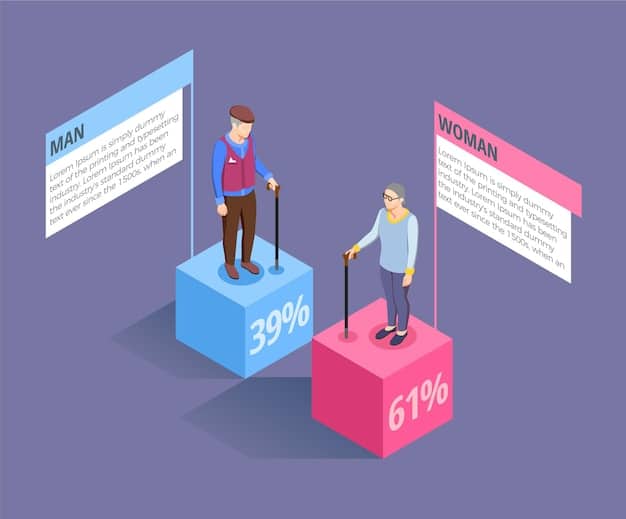SECURE Act 2.0: How It Changes Your Retirement Savings in 2025

Understanding the New SECURE Act 2.0: How It Impacts Your Retirement Savings in 2025 involves numerous provisions designed to enhance retirement savings opportunities, including increases in the age for required minimum distributions and expanded access to workplace savings plans.
Planning for retirement can feel like navigating a complex maze, especially with ever-changing laws and regulations. The Setting Every Community Up for Retirement Enhancement (SECURE) Act 2.0, building upon the original SECURE Act, introduces significant changes that will impact your retirement savings strategies. This article, Understanding the New SECURE Act 2.0: How It Impacts Your Retirement Savings in 2025, provides a comprehensive overview of the key provisions and how they may affect your financial future.
Key Provisions of the SECURE Act 2.0
The SECURE Act 2.0 is a bipartisan piece of legislation designed to improve retirement security for Americans. It builds upon the foundation laid by the original SECURE Act and introduces several new provisions aimed at increasing savings opportunities, reducing penalties, and simplifying retirement plan administration.
Understanding these key provisions is crucial for making informed decisions about your retirement savings. Let’s delve into some of the most significant changes.
Raising the Age for Required Minimum Distributions (RMDs)
One of the most notable changes is the gradual increase in the age at which you must begin taking Required Minimum Distributions (RMDs) from your retirement accounts. This adjustment recognizes that people are living and working longer, allowing them to defer withdrawals and potentially benefit from continued tax-deferred growth.
Previously, the RMD age was 72. The SECURE Act 2.0 raises this age in phases:
- Starting in 2023, the RMD age increased to 73.
- In 2033, the RMD age will further increase to 75.
Expanded Access to Retirement Plans
The SECURE Act 2.0 also seeks to expand access to retirement plans for part-time workers. This measure aims to include more individuals in employer-sponsored retirement plans, increasing their opportunities to save for retirement.
Here are some of the key changes related to expanded access:
- The act reduces the service requirement for long-term, part-time employees to be eligible to participate in 401(k) plans.
- This ensures that more part-time workers can access the benefits of employer-sponsored retirement savings.

In summary, the SECURE Act 2.0 introduces vital changes to RMDs, facilitating postponed withdrawals and prolonged tax-deferred growth. Furthermore, it broadens retirement plan accessibility for part-time employees, empowering them to save through employer-sponsored initiatives.
How the SECURE Act 2.0 Impacts Your Retirement Savings
The SECURE Act 2.0 doesn’t just change the rules; it reshapes the landscape of retirement savings. Understanding how these changes directly impact your personal financial strategy is vital for optimizing your retirement plan and ensuring a secure future.
Let’s explore some specific ways the SECURE Act 2.0 will impact your retirement savings.
Delaying RMDs: A Strategic Opportunity
The increase in the RMD age provides a strategic opportunity to delay withdrawals, potentially allowing your retirement savings to grow for a longer period. This can be particularly beneficial if you don’t need the funds immediately and prefer to let them continue compounding tax-deferred.
However, it’s crucial to consider the tax implications. Delaying RMDs means you’ll eventually face larger withdrawals, which could push you into a higher tax bracket. Carefully assess your financial situation and consult with a financial advisor to determine the best course of action.
Impact on Roth Accounts
The SECURE Act 2.0 also introduces some changes that affect Roth accounts. These accounts offer tax-free withdrawals in retirement, making them a valuable tool for retirement savings. The new legislation aims to enhance the appeal and accessibility of Roth accounts.
One notable change allows employers to make matching contributions to employees’ Roth 401(k) accounts. This provides an additional incentive for employees to contribute to Roth accounts and benefit from tax-free growth.
Penalty Reduction for Missed RMDs
Prior to the SECURE Act 2.0, failing to take your RMD on time could result in a hefty penalty of 50% of the amount you should have withdrawn. The new legislation significantly reduces this penalty to 25%, offering some relief for those who make inadvertent errors.
- Additionally, if the error is corrected in a timely manner, the penalty can be further reduced to 10%.
- This change provides a more lenient approach to RMD compliance and reduces the financial burden of unintentional mistakes.
The SECURE Act 2.0 grants strategic RMD delays, optimizes Roth accounts via employer contributions, and mitigates missed RMD penalties. Grasping these nuances is vital for sound retirement planning and bolstered financial security.
Specific Provisions That Take Effect in 2025
While many provisions of the SECURE Act 2.0 are already in effect, certain changes are slated to take effect in 2025. Understanding these upcoming changes is crucial for staying ahead of the curve and preparing your retirement savings strategy accordingly.
Let’s examine some of the key provisions that will be implemented in 2025.
SIMPLE and SEP Roth Options
Starting in 2025, the SECURE Act 2.0 allows SIMPLE (Savings Incentive Match Plan for Employees) and SEP (Simplified Employee Pension) plans to offer Roth options. This provides greater flexibility for small business owners and self-employed individuals who want to save for retirement on a tax-free basis.
By offering Roth options, SIMPLE and SEP plans can attract more participants and encourage greater retirement savings among small business employees and entrepreneurs.
Student Loan Matching
Another significant provision taking effect in 2025 allows employers to make matching contributions to employees’ retirement accounts based on their student loan payments. This innovative approach recognizes the burden of student loan debt and helps employees save for retirement while paying down their loans.
Here’s how the student loan matching provision works:
- Employers can match employees’ student loan payments as if they were retirement contributions.
- This allows employees to receive the full benefit of employer matching, even if they are unable to contribute directly to their retirement accounts due to student loan obligations.
Emergency Savings Accounts
The SECURE Act 2.0 also encourages employers to offer emergency savings accounts linked to their retirement plans. These accounts allow employees to set aside funds for unexpected expenses without incurring penalties or taxes.
- Contributions to emergency savings accounts are typically made on an after-tax basis.
- Withdrawals are generally penalty-free, providing employees with easy access to funds in times of need.
In essence, by 2025, SIMPLE and SEP offerings will feature Roth alternatives, aiding tax-free savings. Simultaneously, student loan matching will tackle debt while promoting retirement contributions, complemented by emergency savings accounts for unforeseen costs.
Strategies to Maximize Benefits Under the SECURE Act 2.0
The SECURE Act 2.0 presents numerous opportunities to enhance your retirement savings. To fully capitalize on these benefits, it’s essential to adopt strategic planning and make informed decisions that align with your financial goals.
Let’s explore some effective strategies to maximize your benefits under the SECURE Act 2.0.
Review and Adjust Your Retirement Plan
The first step is to review your existing retirement plan and assess how the SECURE Act 2.0 impacts your current strategy. Consider whether you need to make adjustments to your contribution levels, investment allocations, or withdrawal plans.
Pay close attention to the changes in RMD ages and Roth account options. Determine whether delaying RMDs or converting traditional retirement accounts to Roth accounts could benefit your overall financial situation.
Take Advantage of Employer Matching Contributions
Employer matching contributions are a valuable benefit that can significantly boost your retirement savings. Make sure you’re contributing enough to your retirement account to receive the full employer match.
If your employer offers student loan matching, take advantage of this program to simultaneously pay down your student loans and save for retirement.
Consider Roth Conversions
Roth conversions involve transferring funds from traditional retirement accounts to Roth accounts. While conversions are subject to income tax, the subsequent growth and withdrawals are tax-free.
Roth conversions can be particularly beneficial if you anticipate being in a higher tax bracket in retirement. By paying taxes on the converted amount upfront, you can avoid paying taxes on future growth and withdrawals.

The SECURE Act 2.0 encourages proactive plan reviews, optimizing employer matches, and assessing Roth conversions for possible tax advantages. Effective strategy is vital for maximizing fresh benefits and guaranteeing a comfortable retirement.
Common Misconceptions About the SECURE Act 2.0
Despite its widespread impact, the SECURE Act 2.0 is often misunderstood. Clearing up these common misconceptions is crucial for making informed decisions and avoiding potential pitfalls.
Let’s debunk some prevalent myths surrounding the SECURE Act 2.0.
Myth: The SECURE Act 2.0 Eliminates RMDs
One common misconception is that the SECURE Act 2.0 eliminates Required Minimum Distributions altogether. While the act does raise the RMD age, it does not eliminate RMDs entirely. You will still be required to take withdrawals from your retirement accounts eventually.
It’s important to understand the specific RMD rules and plan accordingly to avoid penalties.
Myth: The SECURE Act 2.0 Only Benefits the Wealthy
Another misconception is that the SECURE Act 2.0 primarily benefits wealthy individuals. While some provisions may offer advantages to high-income earners, the act also includes several provisions that benefit middle- and lower-income individuals.
For example, the expansion of access to retirement plans for part-time workers and the student loan matching provision can significantly benefit those who may have struggled to save for retirement in the past.
Myth: The SECURE Act 2.0 Is Too Complicated to Understand
Some people may feel overwhelmed by the complexity of the SECURE Act 2.0 and assume it’s too difficult to understand. While the act does contain numerous provisions, it’s not impossible to grasp the key concepts and how they impact your retirement savings.
- Start by focusing on the provisions that are most relevant to your situation.
- Consult with a financial advisor who can help you navigate the complexities of the SECURE Act 2.0 and develop a personalized retirement plan.
To summarise, it’s wrong to think the SECURE Act 2.0 gets rid of RMDs totally, primarily helps the rich, or is impossible to grasp. Pinpointing these false beliefs is crucial for making educated choices and maximizing the Act’s advantages.
Expert Opinions and Future Outlook
To gain a deeper understanding of the SECURE Act 2.0 and its potential long-term effects, it’s helpful to consider the opinions of financial experts and analysts. Their insights can provide valuable perspectives on the act’s strengths, weaknesses, and future outlook.
Let’s explore some expert opinions and projections regarding the SECURE Act 2.0.
Expert Perspectives on Retirement Security
Many financial experts believe that the SECURE Act 2.0 is a positive step toward improving retirement security for Americans. They applaud the act’s efforts to expand access to retirement plans, reduce penalties, and simplify retirement plan administration.
However, some experts caution that the act is not a panacea and that further reforms may be needed to address the challenges facing the retirement system.
Potential Long-Term Effects
The long-term effects of the SECURE Act 2.0 are still uncertain, but some analysts predict that the act could lead to increased retirement savings rates, improved financial security for retirees, and a more resilient retirement system.
The act’s impact will depend on various factors, including economic conditions, individual savings behavior, and the effectiveness of employer-sponsored retirement plans.
The Role of Financial Advisors
Financial advisors play a crucial role in helping individuals understand and navigate the SECURE Act 2.0. They can provide personalized guidance on retirement planning, investment management, and tax strategies.
If you’re unsure how the SECURE Act 2.0 impacts your retirement savings, consider consulting with a qualified financial advisor who can help you develop a tailored plan that meets your specific needs and goals.
Expertise underlines SECURE Act 2.0’s role in bolstering retirement confidence, though it’s no cure-all. Analysts foresee amplified savings, stronger retiree finances, and advisory support, guiding custom plans for each individual’s goal.
| Key Point | Brief Description |
|---|---|
| 📅 RMD Age Increase | RMD age increases to 73 in 2023 and 75 in 2033. |
| 💼 Expanded Access | More part-time workers can participate in 401(k) plans. |
| 💰 Roth Options | SIMPLE and SEP plans can offer Roth options starting in 2025. |
| 🎓 Student Loan Match | Employers can match student loan payments with retirement contributions. |
Frequently Asked Questions (FAQ)
▼
The SECURE Act 2.0 is a follow-up to the original SECURE Act, designed to further enhance retirement savings opportunities for Americans through various provisions.
▼
The SECURE Act 2.0 raises the age for Required Minimum Distributions (RMDs) from 72 to 73 in 2023, and eventually to 75 in 2033, allowing for delayed withdrawals.
▼
Starting in 2025, the SECURE Act 2.0 allows SIMPLE and SEP plans to offer Roth options, enabling tax-free retirement savings for participants.
▼
Employers can match employees’ student loan payments with contributions to their retirement accounts, helping them save while paying off debt.
▼
The SECURE Act 2.0 encourages employers to offer emergency savings accounts linked to retirement plans, providing employees with penalty-free access to funds for unexpected expenses.
Conclusion
The SECURE Act 2.0 represents a significant step forward in enhancing retirement security for Americans. By understanding its key provisions and implementing strategic planning, you can maximize your retirement savings and secure a more comfortable future. Stay informed, consult with financial professionals, and take proactive steps to make the most of these new opportunities.





